In my 400 nights or so wild camping around the world, I've tried all sorts of approaches to dinner - everything from the full-on dirtbag to a 4-course dinner, and all cooked on a camping stove of course.
And I can safely say that having a hot meal and a cuppa to look forward to after a long day in the great outdoors can be a game-changer.
Now 'camping' means different things to different people - from ultralight backpacking and bikepacking to car camping and even RV'ing. So the best camping stove for anyone will depend on a number of things. I've included a buying guide and relevant picks by category to make sure you get the best camping stove for you.
Whilst the MSR Whisperlight (or perhaps the Primus Primetech 2.3L Stove) maybe the best in class when it comes to backpacking stoves, they do cost a fair bit. I wouldn't say they are expensive because I think they are well worth every penny, but if they are just out of your price range then the Terra Hike Portable offers a great alternative.
It's cheap. Really cheap. And it boils 1 litre of water in 3 minutes. So it's fast. Really fast. This means you'll save fuel and get to dig into dins super quick.
Unlike many of the more expensive portable stoves, the Terra Hike comes with a Piezo (in-built) ignition. So you'll still be able to enjoy a hot cup of coffee even if you forgot the matches.
The flame is also adjustable so you won't have the same troubles as some of the other more powerful yet less flexible options available.
It's made of stainless steel and aluminium alloy which make the camping stove top easy to clean and fairly robust. Despite its small size it can support 18 litres of cookware making it useful for larger groups.
At just 325 grams it's also very light. The folding design means it packs away small (12cm x 9cm x 7cm) making it ideal for backpacking. It comes with a plastic case to keep it from getting squashed.
With 3.5 kW of power, it also kicks out a decent amount of heat making cooking nice and easy.
The Terra Hike Portable Stove is compatible with most cartridges.
There have been some complaints with the ignition and worries about leakage. You also have to consider the build quality at the price. Having said that, most of its competitors don't even come with an inbuilt lighter and many in the community swear by this one so if you need a budget camping stove, it's certainly well worth a look, especially if you're not looking to spend a lot.
Stove fuel type - canister
This thing is ace!
Look at it. It looks ready to launch you into space. Unfortunately, it might not take you to Mars, but it can charge electronic devices using a USB cord.
Turning fire into more battery time for the DSLR, phone, or GPS is awesome. For that alone, this one deserves a special shout out. It's not just a gimmick though. The Biolite also does a good job of producing a decent flame and heat to cook on.
It's very capable of cooking meals as well as boiling water.
At 940 grams it's still a very portable stove, small enough to carry in your pack. However it's around 3 times the weight of the Jetboil and more than double the MSR Windburner (so not for the ultralight crew).
Not needing to carry any fuel is a major bonus. If you've ever spilt fuel in your bag you'll really appreciate this.
So how does it work?
The Biolite first captures heat from the fire. This heat is then converted into electricity through the thermoelectric generator. That electricity then powers the fan and supplies electricity to the USB charging port. Extra power charges up the internal battery so you can charge later too. Genius.
The internal fan drives air back into the burner to help create almost smokeless flames which are banging for cooking on - not only because it's cleaner but also faster.
There are a couple of notable downsides though.
Firstly, you need to keep feeding that fire regularly to retain a decent flame so it requires a lot of twigs / wood.
And secondly, it needs suitable fuel to be available in the first place. If it's wet, you're above the treeline, or you're in the middle of the desert this isn't going to do you much good. Having said that, most people reading this will be camping in Europe and North America where you're likely to be able to find plenty of fuel. If you've always hankered after trying a wood burning stove, this could be the one for you...
This should go without saying, but only burn deadwood, never chop down trees for fuel...
There is also a load limit of 3.6kg for food and pans. This is more than enough for a couple of people but not suited to larger groups.
The Biolite is one of the best camping stoves going if you're going to be somewhere with fuel to burn, don't mind spending a bit of cash, and like your gadgets charged.
Stove fuel type - Solid (organic)
Burn time - N/A
Boil water time 1 litre - 2.5 minutes
Weight - 940g
Stove fuel type - canister
Burn time - 110 minutes
Boil water time 1 litre - 2.5 minutes
Weight - 340g
Whilst this stove may not burn 3 types of fuel, or charge your gadgets for you (coming up), the Campingaz Camp Bistro is often the best camping stove for many of you.
The Camp Bistro is super easy to use, and more than powerful enough with a 2.2 kW hob stove. The heat is easily adjustable so cooking on it is easy breezy.
At 1.4 kilos it's not the lightest camping stove available but on shorter hikes / day hikes you could easily carry this in your backpack. It comes with a stove carry case for easy transport too.
Where it really comes into its own though is when using your car for camping or staying in a campsite.
It's very cheap, it's pretty fuel efficient, comes with a piezo igniter (inbuilt ignition), and is pretty robust in its design. It's also one of the easier to clean cooking stoves here, keeping maintenance to a minimum
Butane cartridges are readily available so getting fuel shouldn't be a problem. Just note that disposing of these cartridges after use comes at an environment cost so not one for the green explorer. The run time is estimated at up to 1 hour 30 minutes on the Campingaz CP250 cartridge. You don't need to buy Campingaz cartridges for this by the way...
Another downside is that whilst it has sufficient power in terms of Watts, it's slow compared to many of the other camping gas stoves featured here at 5 minutes 25 boil time.
Stove fuel type - canister
Burn time - 110 minutes
Boil water time 1 litre - 5 minutes 25 s
Weight - 1.4kg
This gas stove is one of the best camping stoves for family camping or festivals.It's nice and big so give you the option to cook two dishes at the same time.There are two high-performance and fully adjustable 1.5 kW stainless steel burners which give plenty of heat to the pans and start chucking out some decent heat relatively quickly.It also comes with a 1.5kW downward burner with a toast rack and tray. Sounds amazing, I know, but this could do with some improvement so the two regular burners remain its strength.
The lid acts as a wind guard offering good protection but the sides remain exposed so you might find yourself swivelling round to stay protected. I'd like to see wind flaps on each side but given the amount of heat the burners throw out, this isn't a major issue.
Given its size, this is one of the most versatile stoves for camping. You'll be able to rustle up pretty much anything you fancy making this a solid option.
It weighs in at 4kg which is fairly middle of the range for a family camping portable gas stove. It's also 60cm wide which means you have plenty of space but won't have trouble finding somewhere to house it, unlike some of the monster stoves available.
It runs off a gas cylinder which is sold separately and I'd recommend using it with the regulator and hose (also sold separately)
Finally, this stove is cheap as chips so easy on the wallet, especially compared to some of the other stoves on the market.
Stove fuel type - canister
Burn time - 110 minutes
Boil water time 1 litre - 3.5 minutes
Weight - 4kg
After much deliberation, this was the stove we chose for our 18 months bikepacking trip. It served us very well and we (well, my girlfriend) used it to cook up some real yummies. I do wash up like a champ though....
When travelling through different countries, the ability to burn different types of liquid fuel is essential. In Europe and North America, it's pretty easy to find beautifully clean-burning white gas (AKA Coleman's). It's a lot harder to come by in the remote mountain villages of Guatemala though.
Having the ability to burn petrol meant hot dinners were still on the menu even when well and truly off the beaten track. Just know that petrol is more 'dirty' to burn so you'll have to do more maintenance, cleaning things out so only use this option where necessary (more on this in top tips further down if you're interested).
The stove is light, robust, easy to use, and efficient. It performs brilliantly in extreme weather, high winds, and at altitude. The Whisperlite is also fast boiling, which makes it fuel efficient.
It's well worth learning how to clean this bad boy before you go deep into the backcountry though. Ours clogged up after a couple of months when we were about 5 days into a remote canoe trip down the Yukon River in Canada, literally days from the nearest town. Fortunately, an Austrian engineer came floating down the river to the rescue and saved me from having to read the instruction manual on my phone.
Be sure to keep the maintenance kit handy as over a longer trip you're likely to have to clean things out and replace O rings.
This super portable backpacking stove also comes with a guard for wind protection which comes in very handy in more testing weather.
One drawback of the Whisperlite is that it's difficult to get it to do anything other than full steam ahead. Sometimes you want to simmer and that can be tough. A good trick is to take the pot off the heat, blow out the flame, unscrew the top of the fuel bottle to depressurise and then only pump the primer a couple of times before lighting, as opposed to the 20 recommended for normal use. You're welcome!
In terms of price, it's certainly not the cheapest stove of this kind, but if you want a reliable option that has been proved out in the field for nearly 20 years, you'll struggle to do better than this.
The MSR Windburner is also a very good option if you're looking from something more like the Jetboil design (great fuel burning efficiency, simple to use, but more limited in cooking options).
Stove fuel type - Liquid fuel (multi)
Burn time (white gas) - approx 155 minutes
Boil water time 1 litre (white gas) - 3.5 minutes
Weight - 318g
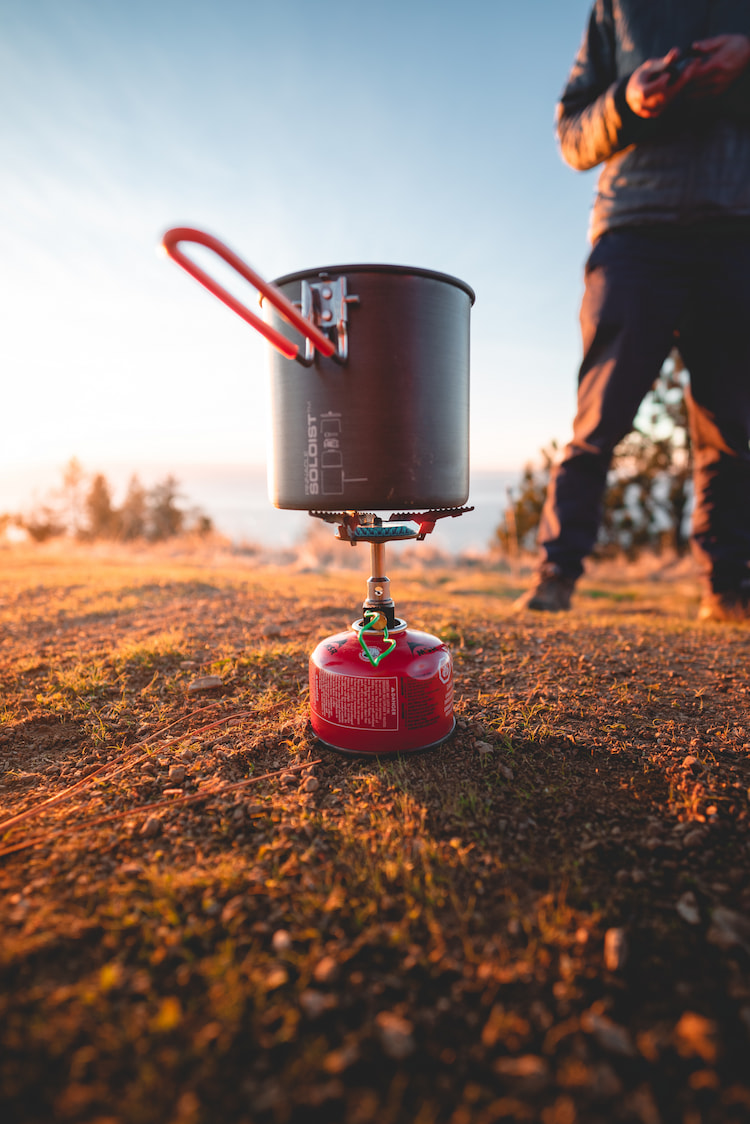
Here are the best camping stoves:
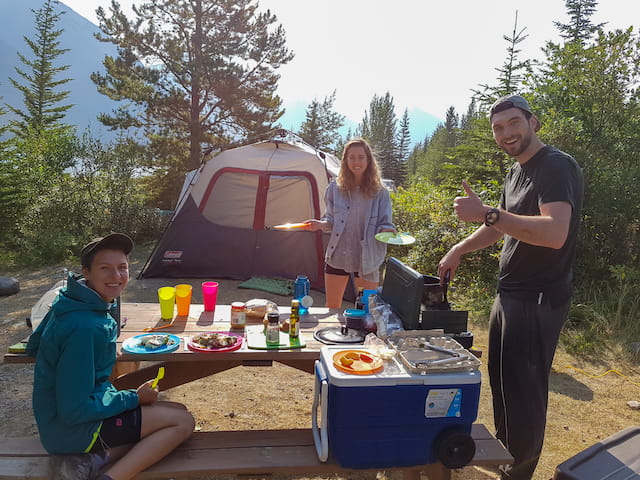
Car campers and the like have the luxury of not really having to worry about the weight or size of their camping gear. You lucky badgers can just focus on things like efficiency, cost, fuel type, ease of use, durability, all of which we'll get to.
Given you can bring a much bigger and heavier gas stove you'll be able to cook a wider ranger of tasty meals. Winning!
That's you backpackers, ultralight thru-hikers, bikepackers, kayakers and pack-rafters. Weight and bulk will be a much bigger (potentially massive) factor if you're going to be lugging the camping stove around on your back. Having said that, you don't always need to go for an ultralight gas stove and if you often travel in a group or couple, you can share the weight between you.
Below you'll find some specific recommendations for the best cooking stove for longer and short human-powered adventures.
What you're going to cook largely depends on what type of trip you're on.
Are you going on quick weekend microadventures where you're just looking to boil up some water for your dehydrated meal and a coffee in the morning? If so, go with one of the light, more simple camping stoves.
If you're on an extended trip, like our 18 months bike trip off-road from Alaska to Panama, you'll still need to think about weight but you'll want to be able to do some 'proper cooking'.
So keep in mind trip type and duration when judging camping stoves.
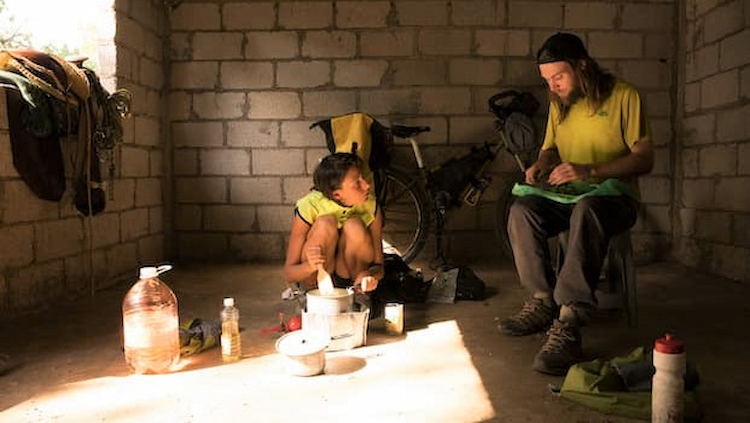
If it's just you or you and a friend, small gas camping stoves are perfect for the job. If you're camping with family and want to cook food that really fuels you all up, then go for one of the more substantial stoves below. You could even consider a cooking system that has more than one burner to accommodate all your pots and pans.
Camping stoves run on three main types of fuel:
Each has its own strengths and drawbacks.
+ Fairly readily available (in the West)
+ Uses easy to screw on gas cartridge/ gas bottle which is simple to use
+ Low maintenance
- Single-use ones are bad for the environment (refillable options available)
- Not good in more extreme conditions
+ Good in winter camping conditions, at high altitude, and in bad weather
+ Super accessible if multifuel burning (diesel and kerosene can be very 'dirty' and clog things up)
+ Great for longer trips especially when off the beaten track
- Can be expensive
- Requires maintenance
+ You don't have to carry or buy the fuel or fuel canister
+ Easy to use on any camping trip
- Not good in the wet or when nothing to burn
- Not allowed in some places
- Only suitable for 'light use' like boiling water
- Not good when very windy / extreme weather
+ Better for the environment
+ No need to buy or carry any fuel
- Need sunlight. Not great for England or midnight feasts...
Top tip:
If you're planning an adventure overseas, go for a multifuel burning stove so you'll always have access to some type of fuel. The ability to use petrol is a lifesaver in remote places. Just know that you'll want the lowest octane available. The higher the octane, the greater the amount of ethanol. Ethanol blocks camping stoves up a treat, so stay away from it where possible.
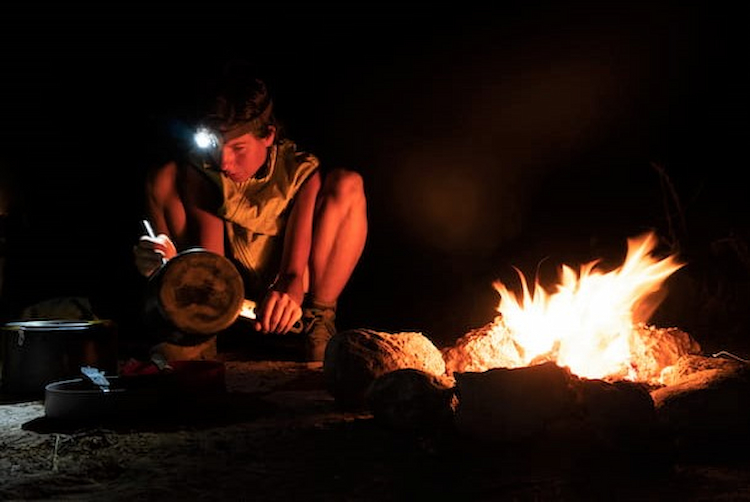
Whilst you can buy a real fancy pants burner for camping, they often cost a pretty penny. If you're looking for something cheap but that gets the job done, we've got you covered.
Just remember that in addition to the initial cost of the stove you also have to buy fuel and potentially additional canisters.
The burn time is how long it takes for your stove to burn a set amount of fuel. The boil time...you guessed it. The quicker the boil the better when you're in need of a hot drink, but this can come at the expense of fuel efficiency so a stove like a flamethrower isn't always the best thing for being fuel efficient. In general, quicker cooking means less fuel usage.
Safety switches can be a lifesaver, literally, although they aren't strictly necessary.
I can't even begin to tell you how disappointing it is to spend ages prepping dinner after a 10-hour hike only to accidentally kick it over before realising that was your last bit of grub for the evening. Especially important for those with kids and clumsy friends...
Buying a longer-lasting model can be more expensive but is worth it if you're going to use it over the long term and is also better for the environment.
Buying a quality camping stove is a good investment. Opting for a poorly built stove will come to bite you when you and the gang are hungry after a hard days trekking. It doesn't have to be expensive. The recommendations below should all last.
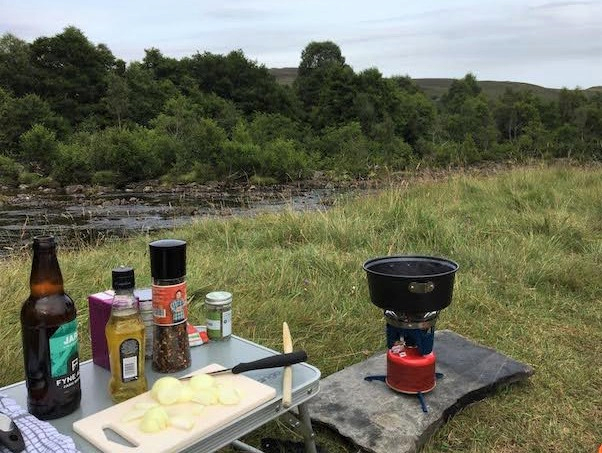
Bonus tips
Often used on camping trips, in the garden or even on a boat, portable stoves are handy but can be dangerous.
Be very careful using them (or don't use them at all) in enclosed areas for example inside tents or vans. Design flaws, gas leakages (carbon monoxide poisoning), explosions, and burning are all things to be aware of.
Even the best camping stoves can be potentially dangerous. Carbon monoxide is odourless and can be lethal so take care.
Different gas stoves take different types of gas canister. Some of the best camping stoves like the Terra Hike Portable are compatible with a wide range of gas canisters.
Campingaz makes their own portable gas canisters like the CP250. Coleman is another popular brand who offer gas canisters like the Coleman C300. The size of the gas canister is also important. Opt for a bigger variety like the Coleman C500 for longer burn times.
Remember that one gas canister may be filled with a different mix to another. Be sure to check that both the fitting thread and the mix of gas in the gas canister is compatible with your camping stove.
A Piezo ignition gas stove means that your camping stove comes with an ignition button. A Piezo Igniter is a god send when you've forgotten or can't find the matches.
Less durable stoves can see problems with their igniter. A portable stove isn't much good unless you can spark a flame so be sure to bring a back up.
Yes – it’s fine to use your camping stove indoors (it could come in very handy if there’s a power cut!) aslong as you make sure there’s adequate ventilation.
As mentioned, stoves can kick out carbon monoxide which can be deadly in enclosed spaces so make sure you leave the window or door open and switch the stove off as soon as you can.
Camping stoves can be an essential piece of kit for those outdoor adventures. Your stove will give you years of use, but only if it’s properly cared for. Here’s a quick guide to looking after your camping stove;
As mentioned, get to know your stove and be familiar with how to use it properly.
Use the right fuel. Some stoves can use a range of different fuel, but make sure you check, as nothing shortens stove life more than trying to burn the wrong kind of fuel.
Clean your stove after use – wipe any spills off and check for any food spills in the stove’s parts. Some stoves come with a maintenance kit including a cleaning needle and tools to loosen stove parts for easy cleaning. After your trip, give your stove a check-over and a good clean before you store it.
Canister Stoves
Always remove the canister after use and store it separately from the stove.
You may need to clean the jet every so often, especially if your stove stops burning fuel cleanly. Check the manufacturers’ instructions on how to do this or take it into a camping store if you’re unsure.
If you’re storing your stove for long periods, keep it in a dust-proof bag.
The best camping stove depends on your needs and budget. For family camping, the Campingaz Chef Folding Stove is a great option. For longer adventures, the MSR Whisperlight International is certainly one of the best camping stoves available.
The MSR Whisperlite International has been a firm favourite in outdoor circles as one of the best camping stoves due to its reliability, ease of use/repair/and cleaning, adaptability (burning white gas, kerosene, and petrol), size, and durability.
The best single burner camping stove is the Campingaz Bistro. It's easy to use, has 2.2kW of power, comes with a Piezo ignition, is easily cleaned, and comes with an adjustable flame making it a great option for cooking a wide variety of food on. It also comes with a carry case. You'll usually need to buy the gas canister separately.
Whilst the MSR Whisperlight (or perhaps the Primus Primetech 2.3L Stove) maybe the best in class when it comes to backpacking stoves, they do cost a fair bit. I wouldn't say they are expensive because I think they are well worth every penny, but if they are just out of your price range then the Terra Hike Portable offers a great alternative.
It's cheap. Really cheap. And it boils 1 litre of water in 3 minutes. So it's fast. Really fast. This means you'll save fuel and get to dig into dins super quick.Unlike many of the more expensive portable stoves, the Terra Hike comes with a Piezo (in-built) ignition. So you'll still be able to enjoy a hot cup of coffee even if you forgot the matches.The flame is also adjustable so you won't have the same troubles as some of the other more powerful yet less flexible options available.It's made of stainless steel and aluminium alloy which make the camping stove top easy to clean and fairly robust. Despite its small size it can support 18 litres of cookware making it useful for larger groups.At just 325 grams it's also very light. The folding design means it packs away small (12cm x 9cm x 7cm) making it ideal for backpacking. It comes with a plastic case to keep it from getting squashed.With 3.5 kW of power, it also kicks out a decent amount of heat making cooking nice and easy.The Terra Hike Portable Stove is compatible with most cartridges.There have been some complaints with the ignition and worries about leakage. You also have to consider the build quality at the price. Having said that, most of its competitors don't even come with an inbuilt lighter and many in the community swear by this one so if you need a budget camping stove, it's certainly well worth a look, especially if you're not looking to spend a lot.